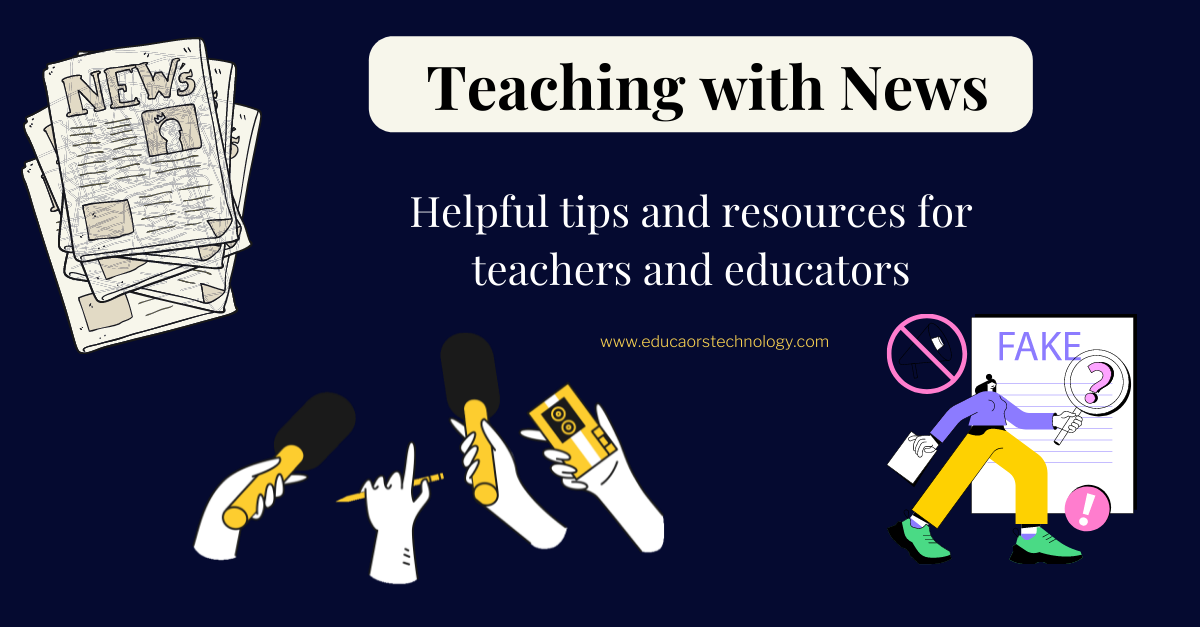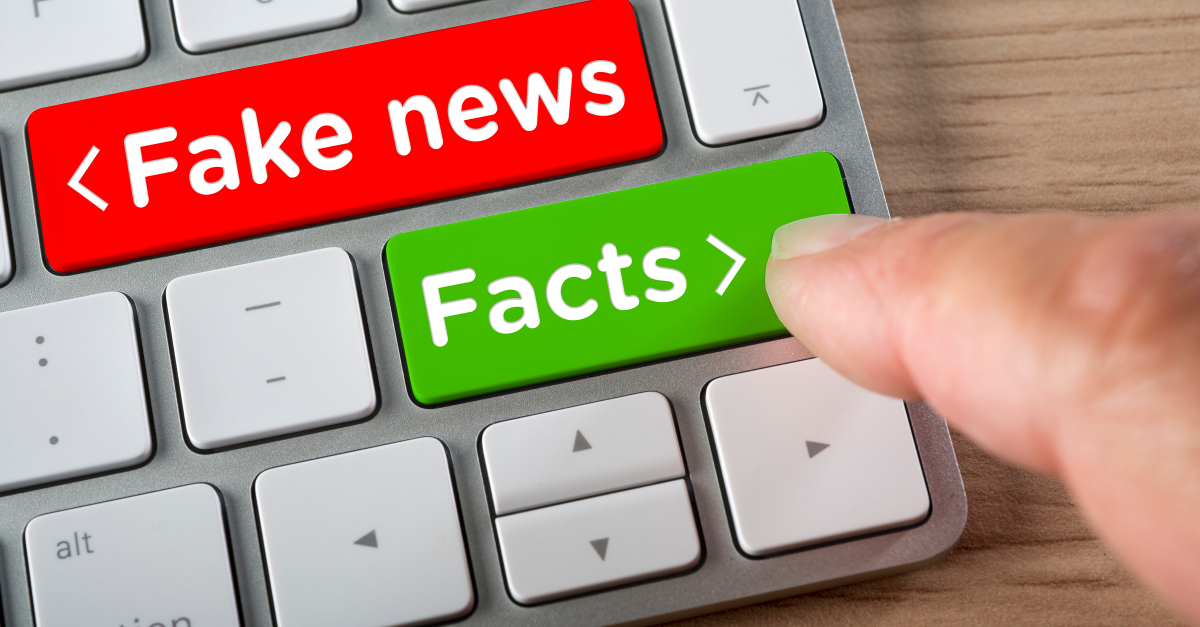With the widespread use of social media platforms and the ubiquity of news stories, teaching students how to critically evaluate sources and sift the good from the bad becomes a pressing pedagogical necessity. The purpose of today’s post is to share with you some helpful resources to use in class to teach students the skills and competencies they need to be media literate. These include the abilities to critically assess the credibility of new stories using various vetting criteria, to spot fake news and false information, to identify reliable sources, and to read and interpret news using a multi-perspective approach.
Teaching using news articles: Ideas and tips for teachers
There are various ways to teach with news. For instance, you can integrate news reading as part of reading comprehension activities. Curate specific news stories from around the web, prepare a set of comprehension check questions, and share with students.
News stories are rich in vocabulary and journalistic jargon which makes them ideal sources to use in teaching vocabulary and to enhance students' grasp of vocabulary and grammar. Students will get to learn how target vocabulary items are being used in real life contexts to create meanings.
If you teach older students, you can use news stories to teach them about the concept of framing and how it affects the process of meaning making and interpretation. Understanding framing will enable students to understand the nuances behind the creation and propagation of certain stories and narratives, discover which perspectives and voices are highlighted s and which are backgrounded or silenced, learn how to detect bias in news reporting, and many more.
Another way to incorporate news stories in your teaching is to use them as speaking or writing prompts. Provide students with headlines and ask them to write their own story version. Assuming the role of journalists will help students practice first-hand the concept of framing and hone in their writing and editing skills. Stories written by students can be used as prompts for open discussion in class, or if you have a class blog or website, you can share them online for others to read and interact with. You can even design your own class newspapers using these newspaper making tools or these editable newspaper templates and invite students to contribute with their own news stories.
You can also use news stories to enhance student speaking (and expressive) skills. Provide students with headlines (use this breaking news generator to help you come up with headline ideas) and invite them to discuss them openly.. Encourage students to voice their opinions and be argumentative all while being ethical, maintaining decorum and respecting each other’s views.
The following are some of the resources that can help you effectively integrate news articles in your teaching:
News stories are rich in vocabulary and journalistic jargon which makes them ideal sources to use in teaching vocabulary and to enhance students' grasp of vocabulary and grammar. Students will get to learn how target vocabulary items are being used in real life contexts to create meanings.
If you teach older students, you can use news stories to teach them about the concept of framing and how it affects the process of meaning making and interpretation. Understanding framing will enable students to understand the nuances behind the creation and propagation of certain stories and narratives, discover which perspectives and voices are highlighted s and which are backgrounded or silenced, learn how to detect bias in news reporting, and many more.
Another way to incorporate news stories in your teaching is to use them as speaking or writing prompts. Provide students with headlines and ask them to write their own story version. Assuming the role of journalists will help students practice first-hand the concept of framing and hone in their writing and editing skills. Stories written by students can be used as prompts for open discussion in class, or if you have a class blog or website, you can share them online for others to read and interact with. You can even design your own class newspapers using these newspaper making tools or these editable newspaper templates and invite students to contribute with their own news stories.
You can also use news stories to enhance student speaking (and expressive) skills. Provide students with headlines (use this breaking news generator to help you come up with headline ideas) and invite them to discuss them openly.. Encourage students to voice their opinions and be argumentative all while being ethical, maintaining decorum and respecting each other’s views.
The following are some of the resources that can help you effectively integrate news articles in your teaching:
1. Behind the Headlines: News and Media Teaching Ideas
The Guardian Foundation offers this collection of educational resources "for teaching students how the media works and how to write and interpret news, and can be used across the secondary curriculum."Teaching Kids News is a good website to help you with integrating news in your teaching. The site offers this interesting resource packed full of tips to help teachers and parents learn how to discuss challenging news stories with kids.
3. How to Recognize a News Story
Nick Robins-Early, from HuffPost, discusses nine practical tips to help spot fake news: 1)Read past the headline, 2)Check what news outlet published it, 3)Check the publish date and time, 4) Who is the author? 5) Look at what links and sources are used, 6)Look out for questionable quotes and photos, 7)Beware confirmation bias.
4. Teaching with Newspaper Activities
Education World outlines ten interesting news-based activities to use with students to teach them key media skills including "reading and writing for meaning, map reading, media literacy, sequencing, word meaning, and math."
5. Using News Articles
Using News Articles by the British Council is a guide to help teachers make the best of news in their instruction. The guide covers the following topics: criteria to help select news articles for students, pre-reading activities, first reading activities, second reading activities, language focus, grammar, follow-up activities, among other activities.
6. What is false information (fake news)?
In this short guide, Webwise.ie discusses why it is important that students use the label false information and not fake news to refer to misinformation and disinformation. It also discusses the rise of the phenomenon of false information and discusses types of false news (e.g., clickbait, propaganda, satire/parody, sloppy journalism, misleading headings, biased/slanted news, imposter content, and manipulated content). It also includes tips to help students spot false information.
7. Fact Checkers
Here are some reliable sources that you and your students can use to verify the credibility of online news:- Snopes: Provides evidence-based facts to refute online rumors and fake news.
- Factcheck.org: Offers tools to debunk viral claims and fact-check science-based claims.
- Teen Fact-checking Network: A virtual newsroom run by middle and high school students who use social media "to debunk viral misinformation and share media literacy tips."
- PolitiFact: A group of journalists dedicated to fact checking news from various sources including TV, news stories, speeches, press releases, campaign brochure, and many more.
8. How to spot fake news classroom posters
Here are two handy posters to use with students in class. The first one entitled How to Spot Fake News is a visual I created a couple of years ago outlining best practices to identify fake news. The visual is based on guidelines sourced from Facebook help center. The second poster is created by the International Federation of Library Associations and Institutions (IFLA) and is available through PennState University Libraries website.
9- Checkology
Checkology is an excellent website that provides educational resources to enhance the teaching of news literacy and to help students become informed digital citizens. These resources include challenges, exercises, fact checking missions, and standards-aligned lessons that cover various topics.
10. The Journal of Media Literacy Education
The Journal of Media Literacy Education features state of the art research on media literacy. It is "an online, open-access, peer-reviewed interdisciplinary journal that supports the development of research, scholarship and the pedagogy of media literacy education. It is the official journal of the National Association for Media Literacy Education."11. NAMLE
The National Association for Media Literacy Education (NAMLE) offers a wide variety of resources to help you teach students how to "access, analyze, evaluate, create, and act using all forms of communication". Some of these resources include a parents guide to media literacy, media literacy in early childhood report, educator's guide to media literacy, and many more.12. Teaching with news: Books for teachers and students
Here are some good books to help with incorporating news in your teaching :A. Fact Vs. Fiction: Teaching Critical Thinking Skills in the Age of Fake News, by Jennifer LaGarde (Author), Darren Hudgins (Author)
"Help students discern fact from fiction in the information they access not only at school but in the devices they carry in their pockets and backpacks."
B. Killer Underwear Invasion!: How to Spot Fake News, Disinformation & Conspiracy Theories, by Elise Gravel
"A hilarious and timely tool to help kids learn how to tell what news is true and what isn't."
C. Developing Digital Detectives: Essential Lessons for Discerning Fact from Fiction in the Fake News Era Paperback, by Jennifer LaGarde and Darren Hudgins
"offers easy-to-implement lessons to engage students in becoming media literacy “digital detectives,” looking for clues, questioning motives, uncovering patterns, developing theories and, ultimately, delivering a verdict."
D. Facts vs. Opinions vs. Robots, by Michael Rex
"A hilarious, timely conversation about the differences between facts and opinions"
E. Can You Believe It?: How to Spot Fake News and Find the Facts, by Joyce Grant and Kathleen Marcotte (Illustrator)
This book "explores in depth how real journalism is made, what “fake news” is and, most importantly, how to spot the difference".




